Sponsored By
ROCK
HARDWARE

Interview: Neil Monteith
[ More Interviews | Video ]
Date:
18th Feb 2003
Intro: Neil has been described as a "new routeing
machine". Originally a Queenslander, Neil was lured down to Victoria
by cooler climes and the prospect of virgin Grampians rock. He's put up a
large quantity of quality routes, including recent development at
Centurion Wall, Red
Rocks and Sentinel Cave in the southern Grampians, though you'll find his
FA's scattered through a diverse range of areas not just in Victoria. He
sport leads up to grade 27, though he's
also a keen aid/big wall climber, mountaineer, ice climber and
photographer, having taken his adventures as far as Baffin
Island in the artic wilderness, New Zealand's Mt Cook, and scaling
such heights as Yosemite's El Capitan in the US. You can read about many
of his exploits at Neil's
Haulbag, and find him on the rock almost every weekend. Chockstone
caught up with Neil during one of his many new routeing exploits in the
Grampians (see: trip report), and
this subsequent interview followed.
Right: Neil on his USA road trip, 1999.
Q: So where did it all
begin? While all the other kids were falling out of trees, what made
little Neil want to scale rocks (using nothing but electrical cord and
tent pegs, or so I've been told) instead? I know you grew up in
Queensland, can I ask whereabouts? What was your first experience with
rock climbing?
My mother was a climber herself in the late 1950’s in Queensland, and I was brought up with tales and adventures on the mountains of Queensland. I was caving, hiking and climbing at a very early age. My first taste of proper roped climbing was at a school camp in 1992 (age 15). We spent a day at Frog Buttress where we top-roped various poxy crack routes. After this camp my friends and I decided we wanted to climb. Instead of finding an instructor, or visiting a gym (they had not arrived in Australia at this time) we just bought some dodgy rope from a hardware store, stole a copy of Royal Robbins book Basic Rockcraft (circa 1960’s) and taught ourselves to climb. I had very little experience with conventional climbing during my first couple of years. We climbed as our own group on various bits of pox around Brisbane using electrical cord and tent pegs as equipment. I placed my own bolts and generally built up some very bad habits. We eventually bought some decent gear and got some advice of some very worried gear shop owners.
I began climbing at
Kangaroo Point where one of the first proper
leads was a grade 18 crack route (Moonlight
Fantasia) with the only rack I had – 3 wires,
steel screwgates and three lengths of 10m tape.
I threaded the tape through the wires and clipped
the huge sling to my lead rope. It didn’t offer
the greatest protection. I didn’t learn about back
clipping until five years into my climbing! I have
always taken the same attitude with my climbing. I
am a self taught aid climber and mountaineer. I may not
be any stronger these days but my climbing gear skills
have greatly improved!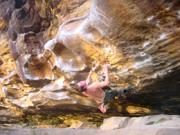
Right: Neil at Sissy Crag, Sydney 2001.
Q: Your first multi-pitch was Carborundum Chimney at Mt Tibrogargan in QLD (where you later put up a number of new routes). It's a tad run out for a first multi. Were those manky pitons there? Care to share the tale?
My mum had told me about the route before I had begun climbing. She described an ascent using three slings and ropes tied around the climbers waists. She told me it was the only route she had ever fallen on – which was not to be taken lightly in the days of ropes that were not designed for climbing. We got a lift to the 350m high Mt Tibrgargon in the Glasshouse Mtns with mum and she left us to go walking. She had no idea what our plans were and neither did we. A chance meeting on the walkup with another climbing party and we gained a route description for Carborundum Chimney.
I set out to lead with our very minimal rack which had grown to about 5 wires and one hex. I set out up the crux chimney pitch with apprehension. It was wide and lacking any obvious gear. Being afraid I squeezed into the back of the chimney – avoiding the easier but more exposed outer edge. My raw knees pushed me higher and higher until I was stopped by a chockstone above my head. This was in fact a piece of vital gear when slung – but I stupidly wedged my knees into a stance and pushed on the rock. It came unstuck and I was squeezed into a chimney holding a heavy rock above my head. I desperately tried to get it back in place but it didn’t go. I yelled down to my partners who were tied into the belay below. The warning was short lived as I let loose the head sized boulder down the funnel shaped chimney. It smashed on top of the guys who held packs above their heads as protection. Luckily no one got injured! I then had to finish the 50m pitch with no protection. My seconds refused to follow, prussiked up the outside and gave up climbing shortly after.
Q: You have been described to me as an eager beaver that gets out on rock every single weekend, and refuses to let your girlfriend stop the car for any reason (other than basic life essentials) on the way to a crag, commenting "The rocks are waiting for me!". I've also heard comments such as "God help you if you are not a morning person on one of Neil's trips. He'll wake you up, insist you feed on an efficient breakfast (no cooking allowed... it takes too long) and have you on the rock by 8am at the latest". I also know you're happy to climb in almost any weather, and treat approach hikes like a sprint race. Is this indeed how you feel and can you imagine your enthusiasm for the sport ever mellowing?
This question is a bit of a wake up call for me! Am I really like you describe? I guess I have always been like that – but recently my partners seem to be slowing down around me in their sheer volume and single-mindness to the sport. I have been climbing for eleven years and have never taken any time off. Even with minor injuries that longest time between climbing has properly been two weeks. At the end of that time I am not a happy camper. I get irritable, fidgety and am known to start climbing the office walls. I love the idea of maximum volume of climbing in the time I have. It is always go go go in my mind.
Fast and light is my usual style – but invariably
this falls over when I forget to bring
something. That just means I have to run back to
the car and get it – which means I have a
chance to beat my previous record for car to
crag times. I guess I have always had this spectre
of ‘old age’ hanging over me. I really feel I have
to get as much done as possible before I get old and
fat.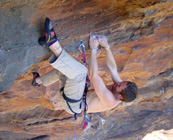
Right: Neil heel hooks the final moves of Army of Ants (27), Sentinel Cave.
Q: What style of climbing do you pursue the most, be it sport, trad, ice, aid, etc?
In Australia I tend to spend a lot of my time sport climbing. The sort of new routes I do usually involve bolts to some degree and these are the lines I am drawn to repeating as well. I climb a cross section of styles though, for instance in the last month I have been granite slab climbing, Grampians crack climbing, gym climbing, overhung sport climbing, urban bluestone bouldering and now I am off to NZ to go mountaineering. I have no attachment to a particular style I guess. I am shit at hard bouldering, I suck at cracks harder than grade 22 (footwork!) and I don’t like the idea of aiding harder than A3.
Q: I've been told you climb exceptionally well on rock, but not so marvellously on plastic. For many, it's the other way around. Can you explain this phenomenon?
I am weak in the body and strong in the mind. Most
of my friends can out boulder me easily on
plastic or rock – but when they get on lead
they seem to hold back on pulling some of the
amazing physical feats they can do at ground
level. I guess I just put 100% into the move
even though I am on lead. I have never really
spent much time in structured training in a gym environment.
I have been trying to get to a gym a couple of
times a week recently but I find it hard to focus
on training to get strong. I just like climbing for
the fun of it I guess. If a move shits me I won’t work
it to death over multiple days – I just move on to
something else that suits me better. I also find physically
I cannot train on plastic for long. My hands
start hurting and my finger tips get trashed very
quickly. Half the time I may not be getting pumped
but having to stop training because I am damaging
my hands to the point of serious injury. I must
have soft baby skin!
Right: Neil Monteith on the first ascent of Stepping on Snakes (23), Sentinel Cave, Grampians.
Q: So what pays the bills? What is it you do for a crust, and how do you find the time to pursue climbing so avidly?
I work as a video editor/designer for a company called MRPPP who does a lot of the television commercials you see in Australia. I am locked up in a dark room with various ad guys for 5 days a week. The pay isn’t super great but I have been doing it for the last seven years or so and they don’t seem to mind that I disappear for extended periods of time during the year for climbing trips. Most people quickly realise that nothing stands between me and my climbing. I would quit my job instantly if they said I couldn’t go on a trip I had planned. The fact is I am only one of about six guys in Victoria who operate certain bits of software so I am moderately in demand and not expendable. I also funnel all my money into climbing. I am a cheapskate when it comes to anything else. I own nothing of value that isn’t climbing related. My trusty Camry climbing car has still got major damage from when I fell asleep at the wheel driving to Arapiles in 1998.
Q: Okay, training. I've gotta ask, because it's always an important question for us flailing hopefuls. Do you indeed train for climbing, and if so what's the deal? I mean apart from prepping for an overseas peak bagging extravaganza. I'm talking about training for your next project or hard red-point.
I don’t tend to train for a specific goal – as I
usually have several projects on the go at one time. I
have two bolted things at the moment – one that is a
crimpy 20m face and another is a very steep cave with
three big dynos in it. I guess my biggest asset is
that I am out climbing on real rock and real routes
almost every weekend. In that way I have built up an
almost intuitive ability to get up most rocks types
and route styles. I never focus just on sport climbing
– as Victoria has so much variety in every style.
When I travelled in the USA for six months in
’99 I would be doing grade 25 limestone sport
routes one day, then granite multipitch crack
routes, then aid walls and finish off the week
with high altitude mountaineering. That is the
reason I have never got very good at any particular
style of the sport.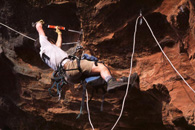
Right: Neil bolts another project at Sentinel, Grampians.
Q: I know you have some preferences on bolting practices. Without stepping on too many toes, can you give us your recommendations, re preferred hardware, spacing, environmental issues, etc., lets say for a classic gramps new route?
I have tried to make my new routes repeatable. I really like the satisfaction of seeing people doing my routes and enjoying themselves. I don’t want to see people shaking in fear at a big runout, badly placed bolt or loose rock. I place my bolts when needed but leave natural placements for gear. A lot of my routes are not sport routes. Australia has a shocking reputation for bolting compared to the rest of the world. In places like the USA and Europe you hardly think twice about the bolting. It is usually always stainless, very well placed and maintained. Whole crags are bolted with the same equipment and style. In Victoria we have thousands of classic routes that are unclimbable by the average guy because the bolts are rusty, reachy or just plain not there! If you are going to establish routes they need to be attractive to others. You shouldn’t be doing it to leave a ‘monument’ to your climbing prowess that no one will repeat. I find many of Steve Monks routes especially in the Victoria Ranges are amazing lines – that are gathering moss and rusting away. He is a very strong climber and I know he didn’t climb them to boost his ego – its just that there are few climbers willing to risk life and limb to just repeat a route. Another thing that shits me is the continual cheap approach to bolting in Australia. A crag like Muline has several of the best steep lines in the Australia – yet all the bolts are cad-plated dynabolts that cost 50c down at Trevs Bargain Emporium.
On average I would spend
$50 to put up a sport route with five bolts and a
lower off. You need to be willing to fork out those sort
of prices if you are going to leave behind a route
that will last the test of time and get repeated.
That is the reason my rack is so old and crappy.
Personally I use stainless glue-in ring bolts and
stainless flush head dynabolts with beefy FIXE hangers.
If you are interested in putting up new routes
then learn form someone who knows how to do it. The
guys at the local hardware store are not the people
to ask! Another thing that irritates me is people
placing little aid working bolts down a steep route
then placing the real bolts off the aid ones. I have
seen many instances of this in the Blue Mtns and Grampians
where a basic rack of natural gear and a skyhook
would have sufficed instead of the bolt gun. It
doesn’t have to be good gear – it just needs to hold
you in long enough to drill the hole. Bolting is a
full body workout on steep routes. I always joke that
I should bring the drill to the gym and practice bicep
curls of the drill whilst hanging one hand of a roof
jug!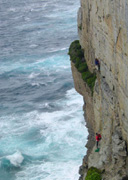
Right: Neil gets scared on the mega exposed Retro (21), Popeye Wall, Point Perp.
Q: What about those photos and vid? Your web site is brimming with many a captured frame, some of which often get voted most popular over on rockclimbing.com, or even turn up in our local Rock Magazine. Apart from being in the right place at the right time, any pointers you'd like to share?
My day to day job involves working with images so I have a good broad base to start with. Ever since I started climbing I was interested in documenting what I did with pictures and sound. If you want to take good photos you have to sacrifice climbing for photography. You will never get great shots if you just pull out the camera whilst on belay and shoot a guys bum disappearing over an overhang 20m above you. Good photos should contain either some sort of landscape to give a feel for the location – or some sort of body rippling, crazy facial expression forearm busting move. A close up shot of some guy on an easy move just doesn’t look exciting. Light is very important. The best photos come about in the last 15 minutes of a sunset, when the world is all warm and fuzzy. Good photographers also have to be bossy. You have to learn to direct the talent a little – if a move looks great then get them to do it again and again until you get the perfect shot with the maximum strain on the climbers face! I usually shoot at least a roll of film a day and at least 4 frames of each photo so I have options. And a last tip – keep the climbers hands and feet in frame!
Q: Okay, Baffin Island. The topic was bound to come up. I saw your presentation in Melbourne last year and, I must say, was mightily impressed with the whole scale of the expedition and your success. Taking on the biggest cliff in the world, in possibly one of the most remote locations. What got that idea into your heads? I mean were you just playing around on Ozymandias at Buffalo one day an thought, "Gee's this things a bit on the small side - lets tick something ten times bigger"?
When I travelled to the USA in 1999 I had my first taste of real mountains. Before that I was your typical Queenslander who had not seen falling snow or owned a decent pair of warm long pants. It was a life changing experience and I loved the organization, effort and extreme reward in climbing multi day routes in the mountains. I climbed Mt Ranier, Grand Teton, El Capitian and Half Dome in Yosemite during this trip.
When I got back to Australia I was climbing at the
urban bouldering crag of Burnley and my friend Marcel
turned up and enthusiastically showed me a magazine
article about climbing in Baffin Island. A picture of
the twin towers of Asgard was particularly memorable. I
was very low on cash at the time after my six months
in the USA but we made the decision then and there. In
two years we would climb at Baffin Island. It was an
easy call to make when you are in the Melbourne suburbs,
but it was surprising how quickly the time goes
by. We had lots of interested people at the start but
they all slowly dropped out until it was just me, Marcel
and Geoff. 
I spent many weekends pushing myself to get the experience I would need for the arctic. Three trips to New Zealand, a winter ascent of Lord Gumtree and lots of ice climbing in Victoria all added to my skills. A month in Yosemite doing walls topped off our training before we left for Baffin Island. In the end we were more than prepared for what we faced when we got there.
Right: Neil's climbing partner on Baffin Island, Marcel, nears the summit.
Q: What's the single most memorable experience you've taken away from the Baffin trip?
The total isolation that Marcel and I had for about 5 weeks during our time in the park. The nearest humans were about 80km away and we had no working radio or anyway apart from walking for four days to get a rescue. We started going crazy after awhile. I heard music playing in the sounds of rushing rivers and every little grass blade became interesting. Must be a bit like jail I guess! The summit of Mt Asgard was simply stunning – we felt like we were the only humans left alive. It is a big football field size flat plan of snow perched onto top of a huge rock tower. I was cartwheeling and screaming for joy up there!
Q: For others thinking of putting together a trip of the Baffin scale, what do you estimate it cost, in terms of dollars spent and time invested in preparations?
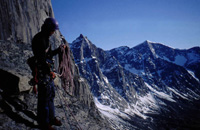 We planned it for about two years and a big guess
would be that is cost somewhere between $15k and $20k
each. It sounds like an incredible amount – but that
included buying lots of equipment, extremely expensive
airfares and the cost of ‘training’ for the area by
travelling to various locations like New Zealand
before we went. We were not sponsored in any way so I
am still paying off the very overdrawn VISA card.
We planned it for about two years and a big guess
would be that is cost somewhere between $15k and $20k
each. It sounds like an incredible amount – but that
included buying lots of equipment, extremely expensive
airfares and the cost of ‘training’ for the area by
travelling to various locations like New Zealand
before we went. We were not sponsored in any way so I
am still paying off the very overdrawn VISA card.
Right: Neil coiling ropes on Mt Thor, Baffin Island, 2002.
Q: You've put up a lot of new routes. Have you got any estimate of how many? Apart from your big achievements like the new route at Baffin, what are the ones that stand out, the local first free ascents you're most proud of?
We didn’t finish our route on Baffin Island. Looking back I think I have put up about 130 routes in Queensland and Victoria. That is the number that I was the leader on – so there are plenty of other routes that I have been involved in as a second. I really like establishing routes that are steep and bolted. I love dangling around in roofs and doing big moves between jugs. I have never had a great desire to wander the more obscure regions of Victoria and establish ground up easy routes. I really think there are plenty of routes out there of that style that are mega classic such as routes at Arapiles. I enjoy consolidating crags – making sure that a good days climbing can be had at each area I develop. It might mean bolting some not so classic lines for the belay slaves to lead and top-rope on.
Ok, now back to the original question. My favourite new routes would have to be Winged Corpse (26) at Centurion as it climbs a mega steepo cave and took me several days to tick (and bolt by hand!). Stone Temptress (22) at Centurion also is a great trad climb along a perfect hand traverse rail. A great line to do that didn’t need bolts! Cut Lunch Walls (Staplyton) has some great routes up perfect orange rock. Wired (22) and Tendor Hooks (24) are my best routes there.
Another highlight was an ascent
of a new aid route on Mt Warning, NSW over three
days. It was a super team effort with Nick McKinnon,
Phil Box and Will Dameron. It has gone free at
25 but the shear effort involved in establishing it was
mindblowing. I am proud of almost all of my new routes.
The Grampians has so much potential waiting to be
tapped. I have hundreds of photos of areas I have hiked
into with potential lines waiting to be done.
Right: Neil on Psychotic Episode (26), Centurion Wall, Grampians.
Q: What's the hardest graded climb you've freed? Was it one of those wild pump fests at Muline, or the Gallery in the Gramps? Or perhaps something from your US trip?
I haven’t really climbed anything that hard. My own new routes are some of the hardest things I have done. Winged Corpse (26), Anti-Christ Superstar (25/26), Strike the First Blow (25) are some of my harder ticks in Australia I guess. At the end of my trip to the states in ’99 I managed to tick two 27’s, and flash several 26’s at a few limestone crags such as Wild Iris (Wyoming) and Jacks Canyon (Arizona). I felt they were soft touch grades though. I am still struggling to beat my lead of Olos Slab (25) at Kangaroo Point when I was 16 years old. It was graded 26 at that time and it meant I climbed ten grades harder than my age! Now every little brat at Nowra climbs that hard on their first week climbing.
Q: What part of climbing gives you the most satisfaction. Ticking a hard grade, putting up an elegant first ascent, or is it something more philosophical, like perhaps a feeling of independence and focus while on lead, or maybe a shared bond with friends?
New routes is my passion. I love exploring areas for potential lines even if people tell me there is no potential. Scrub bashing at a break neck speed, aiming for the bright red cave on the skyline is one of life’s great pleasures! The working of moves on a face that seems unclimbable until you discover a key pocket, the preparation in making it into a well conceived line and finally the feeling of ticking the route after spending days working it. The Grampians is so vast and untouched compared to other countries. Where else can you just pull up under a cliff, walk in for 10 minutes and do five new routes? A lot of European climbers never get the chance to do even one new route in their life. We are very lucky in Australia.
Q: Epics. Climbers love to tell stories around the camp fire of big falls, pulled gear and benightments. You must have had your share? Care to weaves us a yarn?
I really haven’t had that many epics of any grand
scale. Jono and I spent a freezing night with minimal
bivi gear at 3100m on Mt Tasman (NZ) in a natural ice
cave. I was so tired I lay down on the bare ice and
fell asleep. I woke an hour later shivering uncontrollably
and wondering where I was. The only bivi gear we
had were two black plastic animal autopsy bags
that Jono had stolen from his vet science uni department.
We were so cold and had to keep our toes moving
to stop frostbite. We still managed to loose feeling
in our toes for three months after that trip. 
Another memorable experience was with Nick McKinnon on North West Route of Half Dome (Yosemite). On pitch 25 or something it started snowing. The only bivi gear we had was a small blue trap we had purchased for $1 from a hardware shop. We both sat next to each other thinking ‘we are so fucked’. The next day we managed to pull overselves together and climb the last few pitches to summit with very little feeling in our hands. So I guess the lesson learnt is ‘bring bivi gear!’
Right: Neil on the first ascent of Tender Hooks (24), Cut Lunch Walls, 2002.
Q: I understand that a while back you did the FFA of a big multi-pitch called "Sunburnt Buttress" in the Glasshouse Mountains, QLD. Can you tell us a little about that?
It was an idea I had had for many years. After coming back from the USA in ’99 I had experienced big routes which were almost sport climbs. All the belays were fixed meaning you could bail off at any point. I wanted to try and establish a route of similar style on one of the biggest faces in Queensland, the north-east buttress of Tibrogargon (350m). It was the middle of summer and I had very little money – but I took my dole payment and bought a hundred bolts or so and began the bolting. It was a mega project which took me about five days total work by myself.
The rock was very hard so I could only place about 5 bolts per battery – so I would have to rap to the ground and walk to the car to recharge them. One particular day I spent an hour rigging ropes to the ground, walked the 30 minutes to the car and realised I had left the keys at the belay 150m up the route! I had to walk back, jug the ropes, get the keys and get back to the car. One little mistake took about three hours of extra work. By the end of it I was so tired I drove back to Brisbane and went to sleep. I woke suddenly realising I had left my entire campsite still set up at the base of the wall – and it is an area where camping is illegal and thieves abound. I drove up that night to retrieve all my gear.
Climbing the six pitch route at grade
19 was merely a formality. Lee Skidmore and Phil Box
have only recently ‘rediscovered’ that Tibrogargan can
still create big routes. They have established about
five new multipitch routes in the last year, on a
cliff only 50 minutes drive from Brisbane!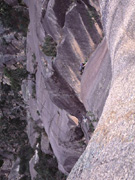
Right: Neil and Jacqui on Status Quo (21) on the south side of the gorge, Mt Buffalo.
Q: What about your "Ozy in day" experience out at Buffalo with Nick McKinnon? Apparently your "speed-aiding" was pretty amazing, leading the first three big pitches continuously.
I had climbed Ozy twice before over multiple days. Nick had not been on it before and was keen to give it a go. I put forward the idea of a one day ascent and it was agreed upon. We drove up late Friday night, arrived at 1am and decided to climb straight away. I wanted to try my short pitching technique, which means running pitches together whilst self belaying – and the second just cleans the gear. After a bit of an epic on the descent we were going at dawn. I shot up the first three pitches and Nick switched over to the lead. Nick’s back problems forced me to take over the reigns to continue aiding the rest of the route up to below the final ugly chimney. We found it soaking wet and covered in moss. With all my might I tried climbing it, but instead slid down the wet sharp granite. It was un-aidable so we decided to head left up a different line. As Nick started this I watched a dark rain cloud begin to build in the distance.
Nicks pitch got us to a hex sided room of hell. It was a chamber with about five offwidth cracklines heading up to the obvious top. Nick tried one and took a huge eight metre whipper down an ugly chimney and got cut up and concussed. It was now my turn to lead us to glory. The rain started, the line I choose was filled with dirt and Nick struggled to second it with the injuries he had sustained. We topped out in daylight and hiked back to the car.
Our original plan was sleep the night and drive home the next day. We both decided it would be better to be home at our respective girlfriends that night. So we drove the four hours home to Melbourne, arriving at 9pm. Melbourne to Ozymandias then back to Melbourne in 24 hours!
Q: I've been told you like the pumpy steep climbs as opposed to the delicate footwork required on thin slabs and the like. Is this true? Was there some nightmare slab that put you off?
I have appalling footwork. Some connection in my
brain must be fried or something. On anything
hard I just forget the feet and start campusing
out of control. That is just how I climb I
guess. Bad finger tendons and bad knees have
made me reluctant to do fancy footwork. I guess
I also like the monkeying around in caves
factor. I still do a fair amount of nasty granite
slabs here and there which I don’t really mind.
Thin crimpy faces are what I usually fail badly at.
Right: Pollux Outcrop, Mt Bogong. Neil leads the hardest route of the weekend 'The Freak' which involved overhung drytooling and ice climbing.
Q: I know you've gone to extremes to find some decent ice climbs in Victoria, given our lack of serious peaks. Did you find anything worthy? How does did it compare to the "real thing" found overseas?
Being a Queenslander I had not seen real snow before I moved to Victoria at age 21. I immediately started exploring the snowy areas of the alps. I bought some cheap ice gear and convinced a super fit non-climber friend of mine (Jono Schimdt) to come ‘mountaineering’ with me. Rather than just plod up and down steep snowslopes (ie Feathertop) we focused on short technical mixed rock and ice routes like I had seen photos of in Canada/USA. The weather conditions to find these sort of routes in Australia are extremely fickle. You generally have to climb in blizzards where the temps have dropped to –10’C or so. A sunny day just produces slushy snow and the thin layer of ice melts.
We have done some fun stuff over the years. Nothing is world class that is for sure – but it is darn good training for the real mountains of the world. Most of our harder routes have been on Victorias highest Mt Bogong which requires a 4 hour walk in. The style is thin ice and frozen dirt on near vertical rock. Protection is usually rock gear, pitons and occasionally a snowstake. The ice is never thick enough for a worthwhile icescrews. We have several other locations we are keen to check out this season.
Q: I understand you wrote a guide to Kangaroo Point in Brisbane at age 17, and continued writing guides from there. More recently I know you've been producing several on-line guides to remoter areas of the Grampians, as well as contributing to the VCC guides. Given that this highly admirable task is also time consuming and financially unrewarding, where does the motivation come from? Giving back to the community? Is it just fun?
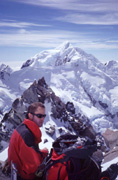 I am a visual person so I love taking photos and
recording information. We used to have some of the
worst guides in the world in Australia. Just lists of
routes with no topos or photos. This has changed in
the last few years with the invention of desktop
publishing. It is now possible for anyone to produce
quality guides to the obscurest areas. Queensland is
renowned for its ‘secret’ climbing underground
where guidebooks and publishing of info is
shunned upon. I tried to change this attitude by
publishing guides to areas that every climber
had a right to visit (ie National Parks). I don’t
believe areas should be kept secret if the area
is public access. I guess I just like showing
people what amazing stuff is out there and
sharing the massive enjoyment I get every time I go climbing.
I have never kept any of the crags I develop a
secret. I actively encourage people to visit and put up
there own new routes.
I am a visual person so I love taking photos and
recording information. We used to have some of the
worst guides in the world in Australia. Just lists of
routes with no topos or photos. This has changed in
the last few years with the invention of desktop
publishing. It is now possible for anyone to produce
quality guides to the obscurest areas. Queensland is
renowned for its ‘secret’ climbing underground
where guidebooks and publishing of info is
shunned upon. I tried to change this attitude by
publishing guides to areas that every climber
had a right to visit (ie National Parks). I don’t
believe areas should be kept secret if the area
is public access. I guess I just like showing
people what amazing stuff is out there and
sharing the massive enjoyment I get every time I go climbing.
I have never kept any of the crags I develop a
secret. I actively encourage people to visit and put up
there own new routes.
Right: Neil resting on the way down from Mt Cook (3700m) New Zealand, 2001.
Q: I believe you've never had a serious injury despite huge amounts of time on the rock. Do you put this down to a safety conscious style, or luck or what?
I have had one injury. I dislocated my knee at the climbing gym in 2000. It was fairly bad and I couldn’t walk for a few weeks, although I did keep climbing the steep stuff! I remember the physio saying ‘you should rest it for 7 weeks’ and I said ‘so can I go mountaineering in 4?’. I guess I climb in my limit. I have not taken any serious falls on natural gear and tend to only try hard steep things which tend to be safer. I guess it is just luck.
Q: Okay, generic question time, what's your favourite crag in Victoria, and all time favourite climb?
The whole Staplyton (Grampians) area is simply amazing. The quality of some of the lines are simply some of the best in the world. For pure rock architecture and variety it is a hard place to beat. I really like how the separate crags are all quite hidden from each other – so you can get away from the tourist hoards. The area will continue to produce top quality hard routes and boulder problems for many years to come.
Q: Do you have a climbing hero/heroine?
The Huber brothers (Alex and Thomas) are my idols.
Those guys can climb French 9a (grade 35) and do
insane aiding at Himalayan altitude. They are also
responsible for freeing several 30+ pitch routes on El
Cap in Yosemite. I met Thomas in Yosemite this year
and he was very down to earth. I also respect Glen
Tempest and Mike Law for their endless enthusiasm for
new routes of every style.
Right: 26th February 2001 - Neil on the summit of Mt Cook. NZ.
Q: So what does the future hold in your climbing career? Any big trips on the cards? I know you're off peak bagging in New Zealand at the end of this week. What's the trip all about? And where to next?
Oh, how I wish it was a career. Making some money back would be great in the future. Hopefully I sell some photos or get something published. This most recent trip is to climb Mt Aspiring in New Zealand. It should be a low key trip with no real problems. In the long term I hope to spend some time in Europe doing some limestone sport climbing and some classic alps mountaineering. The current political climate is not great for trips to the big mountain ranges. I guess a trip to the Himalayas would be good sometime in the next 2-4 years. I am still young so I have lots to look forward too. There is always those undeveloped perfect Grampians caves to explore.
[ All photos above provided by Neil ]
Above: Neil on the an FA attempt of his grade 25 face
project at Gondawannaland in
the Grampians. (See: Trip Report)
 |
*
Neil attempting Army Of Ants, the super overhung grade 26 sport route at Sentinel Cave in the Grampians. From the knee bar rest stance, he powers up, taking a scary fall while clipping, then fights across the roof traverse plunging downwards just shy of the last bolt. |
|
|
*
Falling! Neil takes a sizable whipper on an FA attempt of his grade 25 face project "Faceless" at Gondwannaland in the Grampians. Part Two (3.2 Meg, 52 seconds) - He continues, working the moves to the top. |
 |
*
Neil Monteith takes a ground fall while attempting to onsight a new grade 24 route in the Grampians. His two pieces of protection pulled, leaving him plunging 5m or so to the deck below. Thankfully no serious injuries were incurred. See forum topic for full details. Video taken by James Pfrunder. |
Further Reading: ![]()
Neil's
Haul Bag - Neil Monteith's site. Lots of great photos, and trip
reports around the Grampians area.
Baffin Island - Full details
of the big Baffin adventure including heaps of photos, and video and
audio.
Qurank Interview - An
interview with Neil from Queensland's on-line climbing magazine, Jan 2000.
Home | Guide | Gallery | Tech Tips | Articles | Reviews | Dictionary | Forum | Links | About | Search
Chockstone Photography | Landscape Photography Australia | Australian Landscape Photography
Please read the full disclaimer before using any information contained on these pages.
All text, images and video on this site are copyright. Unauthorised use is strictly prohibited.
